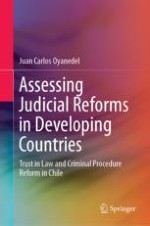2019 | OriginalPaper | Chapter
3. The Analysis of Trust and Criminal Justice: Between Legitimacy and Order
Author : Juan Carlos Oyanedel
Published in: Assessing Judicial Reforms in Developing Countries
Publisher: Springer International Publishing
Activate our intelligent search to find suitable subject content or patents.
Select sections of text to find matching patents with Artificial Intelligence. powered by
Select sections of text to find additional relevant content using AI-assisted search. powered by
